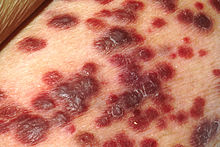AIDS-related complex: Difference between revisions
No edit summary Tags: Mobile edit Mobile web edit |
mNo edit summary |
||
| (15 intermediate revisions by 7 users not shown) | |||
| Line 1: | Line 1: | ||
{{Infobox medical condition (new) |
{{Infobox medical condition (new) |
||
| name = AIDS-related complex |
| name = AIDS-related complex |
||
| synonyms = |
| synonyms = |
||
| image = Kaposi's Sarcoma.jpg |
| image = Kaposi's Sarcoma.jpg |
||
| caption = [[Kaposi's sarcoma]] is a part of AIDS-related complex |
| caption = [[Kaposi's sarcoma]] is a part of AIDS-related complex |
||
| pronounce = |
| pronounce = |
||
| field = [[Infectious disease (medical speciality)|Infectious disease]] |
| field = [[Infectious disease (medical speciality)|Infectious disease]] |
||
| symptoms = |
| symptoms = |
||
| complications = |
| complications = |
||
| onset = |
| onset = |
||
| duration = |
| duration = |
||
| types = |
| types = |
||
| causes = |
| causes = |
||
| risks = |
| risks = |
||
| diagnosis = |
| diagnosis = |
||
| differential = |
| differential = |
||
| prevention = |
| prevention = |
||
| treatment = |
| treatment = |
||
| medication = |
| medication = |
||
| prognosis = |
| prognosis = |
||
| frequency = |
| frequency = |
||
| deaths = |
| deaths = |
||
}} |
}} |
||
| ⚫ | '''AIDS-related complex''' ('''ARC''') was introduced after discovery of the HIV ([[human immunodeficiency virus]]) when the medical community became aware of the inherent difficulties associated with treating patients who have an advanced case of HIV which gave rise to the term [[acquired immune deficiency syndrome]] (AIDS). The necessity for doctors to quickly and accurately understand the specific needs of unknown patients with AIDS in an [[emergency department]] situation was addressed with the creation of the term ARC.{{citation needed|date=January 2021}} |
||
| ⚫ | |||
| ⚫ | '''AIDS-related complex''' ('''ARC''') |
||
| ⚫ | |||
"Laboratory criteria separating AIDS-related complex (ARC) from AIDS include elevated or hyperactive [[B-cell]] humoral immune responses, compared to depressed or normal antibody reactivity in AIDS; follicular or mixed hyperplasia in ARC lymph nodes, leading to lymphocyte degeneration and depletion more typical of AIDS; evolving succession of histopathological lesions such as localization of [[Kaposi's sarcoma]], signaling the transition to the full-blown AIDS."<ref>[https://www.nlm.nih.gov/cgi/mesh/2009/MB_cgi?mode=&term=ARC As listed by the National Library of Medicine under Medical Subject Headings]</ref> |
"Laboratory criteria separating AIDS-related complex (ARC) from AIDS include elevated or hyperactive [[B-cell]] humoral immune responses, compared to depressed or normal antibody reactivity in AIDS; follicular or mixed hyperplasia in ARC lymph nodes, leading to lymphocyte degeneration and depletion more typical of AIDS; evolving succession of histopathological lesions such as localization of [[Kaposi's sarcoma]], signaling the transition to the full-blown AIDS."<ref>[https://www.nlm.nih.gov/cgi/mesh/2009/MB_cgi?mode=&term=ARC As listed by the National Library of Medicine under Medical Subject Headings]</ref> |
||
Clinical use of this term was widely discontinued by the year 2000 in the United States after having been replaced by modern laboratory criteria. |
Clinical use of this term was widely discontinued by the year 2000 in the United States after having been replaced by modern laboratory criteria.{{citation needed|date=May 2021}} |
||
==References== |
==References== |
||
{{ |
{{Reflist}} |
||
== External links == |
== External links == |
||
{{Medical resources |
{{Medical resources |
||
| DiseasesDB = |
| DiseasesDB = |
||
| ICD10 = |
| ICD10 = |
||
| ICD9 = |
| ICD9 = |
||
| ICDO = |
| ICDO = |
||
| OMIM = |
| OMIM = |
||
| MedlinePlus = |
| MedlinePlus = |
||
| eMedicineSubj = |
| eMedicineSubj = |
||
| eMedicineTopic = |
| eMedicineTopic = |
||
| MeshID = D000386 |
| MeshID = D000386 |
||
}} |
}} |
||
| ⚫ | |||
{{Authority control}} |
|||
{{infectious-disease-stub}} |
|||
| ⚫ | |||
Latest revision as of 06:46, 4 October 2023
| AIDS-related complex | |
|---|---|
 | |
| Kaposi's sarcoma is a part of AIDS-related complex | |
| Specialty | Infectious disease |
AIDS-related complex (ARC) was introduced after discovery of the HIV (human immunodeficiency virus) when the medical community became aware of the inherent difficulties associated with treating patients who have an advanced case of HIV which gave rise to the term acquired immune deficiency syndrome (AIDS). The necessity for doctors to quickly and accurately understand the specific needs of unknown patients with AIDS in an emergency department situation was addressed with the creation of the term ARC.[citation needed]
ARC is a "prodromal phase of infection with the human immunodeficiency virus (HIV)" that includes: low grade fever, unexplained weight loss, diarrhea, opportunistic infections and generalized lymphadenopathy.[citation needed]
"Laboratory criteria separating AIDS-related complex (ARC) from AIDS include elevated or hyperactive B-cell humoral immune responses, compared to depressed or normal antibody reactivity in AIDS; follicular or mixed hyperplasia in ARC lymph nodes, leading to lymphocyte degeneration and depletion more typical of AIDS; evolving succession of histopathological lesions such as localization of Kaposi's sarcoma, signaling the transition to the full-blown AIDS."[1]
Clinical use of this term was widely discontinued by the year 2000 in the United States after having been replaced by modern laboratory criteria.[citation needed]
